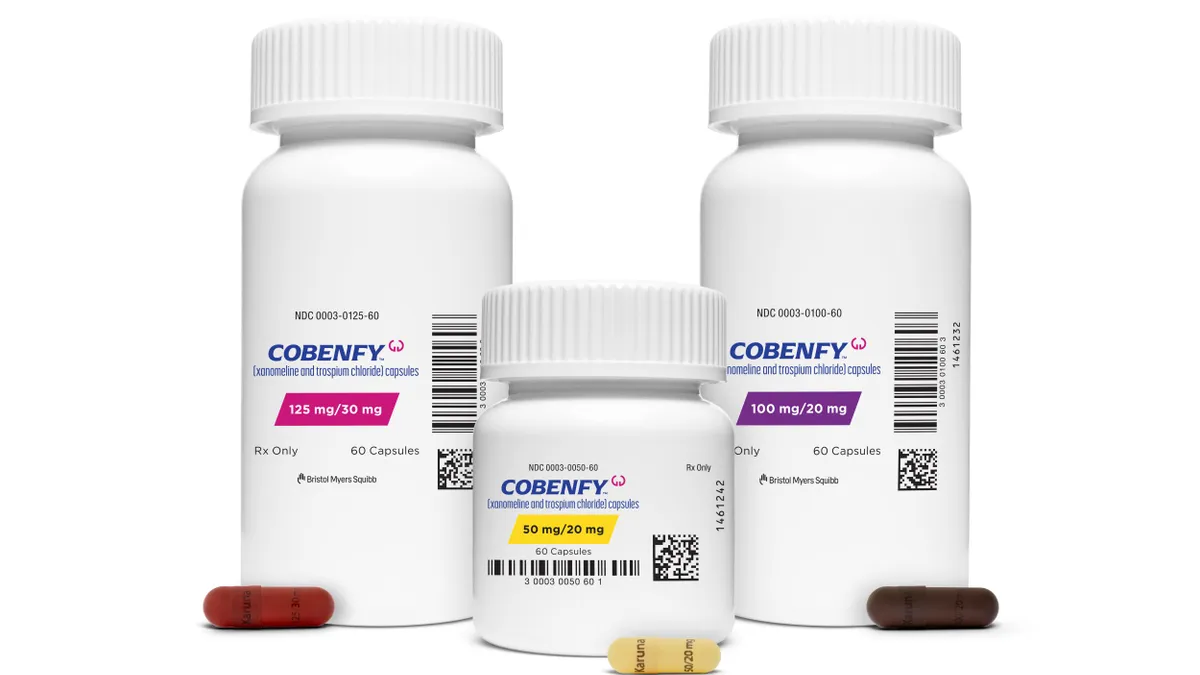Since the first recombinant DNA product was approved in 1982 — Humulin developed by Genentech and marketed by Lilly — biologics have brought tremendous innovation and medical benefits to patients. More than 35 years later, the biopharma industry continues to innovate as scientific and medical knowledge advances.
Biologics — large molecule drugs typically derived from living cells — have had an enormous impact. To date, more than 250 biologic therapies and vaccines have 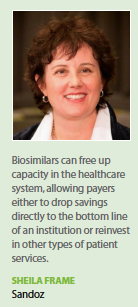 transformed the lives of hundreds of millions of patients. Once debilitating diseases have been drastically modified, and newer therapies are being developed for once life-threatening diseases. Over the last 15 years, there has been a gradual shift of investment dollars from small-molecule drugs to biologics.
transformed the lives of hundreds of millions of patients. Once debilitating diseases have been drastically modified, and newer therapies are being developed for once life-threatening diseases. Over the last 15 years, there has been a gradual shift of investment dollars from small-molecule drugs to biologics.
“As we learn about the natural history of disease and can identify those targets that are responsible for disease, we will be able to target them through the development of biologics," says Carlos Sattler, M.D., VP and head of clinical development and medical affairs at Sandoz. “The opportunities are endless; we are looking at just the tip of the iceberg as it relates to personalized and targeted therapies."
Biologics have significantly higher success rates than conventional small-molecule drugs in terms of development, says Elliott Levy, M.D., senior VP of global development, Amgen. “In large part, the success associated with biologics is due to the lack of off-target toxicity, which essentially eliminates one of the principal causes of failures in small-molecule drug development."
Biologics now account for the fastest-growing segment of prescription drug spending. This market is forecast to reach $399.5 billion by 2025, according to Grand View Research, and by 2022, biologics are expected to contribute 52% of the top 100 product sales, according to an EvaluatePharma report.
The small-molecule market has become crowded and commoditized because in almost every therapy area there are choices, says Pratap Khedkar, managing principal of biopharmaceutical vertical and leader of ZS’s global pharmaceuticals practice.
“As a result of the overcrowding, payers are exerting more control on small-molecule 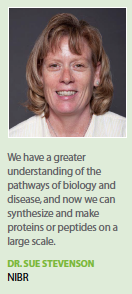 drugs than on their large molecule counterparts — at least until recently," he says.
drugs than on their large molecule counterparts — at least until recently," he says.
“Payers have been able to exert this power because of consolidation over the last 10 years; the five largest commercial plans have almost 45% of the U.S. insured population."
Industry experts say a shift toward biologics will continue to challenge payers and patients, and they are expected to continue to assess pricing, outcomes, and value.
IQVIA Institute for Human Data Science in a report from April 2018 finds that the balance of medicine spending has shifted strongly to specialty medicines, which drove $9.8 billion of the $12 billion net growth of new brands and now accounts for 46.5% of per-person, per-year spending on medicines.
The biologic market grew by 12.6% in 2017, accounting for $11.5 billion in spending. IQVIA predicts over the next five years, 20% of the 40 to 45 new active substances projected to be launched each year will be next-generation biotherapeutics, such as cell-based therapies, gene therapies, and regenerative medicines with costs approaching $100,000.
“In developed markets, we have a growing share of biologics, and more and more of the innovative and specialty drugs that we’re seeing are biologics," says Michael Kleinrock, research director for the IQVIA Institute for Human Data Science.
The share of spending on biologics is increasing for several reasons. “One is the 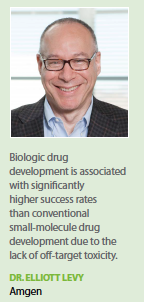 continued innovation in these product areas," Mr. Kleinrock says. “There are more new drugs that are valuable. The other is that there has not, to date, been a significant amount of biosimilarity or patent expiry that takes the brand out of the mix and lowers the spend on it in the same way we see in small molecules."
continued innovation in these product areas," Mr. Kleinrock says. “There are more new drugs that are valuable. The other is that there has not, to date, been a significant amount of biosimilarity or patent expiry that takes the brand out of the mix and lowers the spend on it in the same way we see in small molecules."
Payers are looking for predictability in terms of value. “This is why we’re seeing more outcomes-based contracting and novel payment models that give the payers some insulation from uncertainty," Mr. Kleinrock says.
Biologics’ Impact on R&D
Most of the commercial success in biologics is based on monoclonal antibodies. All of the top-selling biologics are monoclonal antibodies, including AbbVie’s Humira, with 2017 sales of $18.4 billion; Roche’s Rituxan with 2017 sales of $9.2 billion; and Pfizer/Amgen’s Enbrel with 2017 sales of $7.9 billion.
In the pipeline, monoclonal antibodies (particularly biosimilars), conjugated therapeutics (including antibody drug conjugates), and gene therapies and cell therapies (such as CAR-T cells) are expected to dominate most development pipelines in the next five to 10 years, according to a survey of biologics developers by Catalent Biologics.
“When we talk about biologics today, we’re really talking about a diverse group of 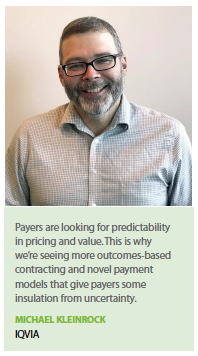 medicines," Dr. Levy says. “Biologics are being targeted for development because in many cases they can do things that can’t be done with conventional molecules."
medicines," Dr. Levy says. “Biologics are being targeted for development because in many cases they can do things that can’t be done with conventional molecules."
According to Statista, the number of biologic drugs, as of the middle of 2017, in development is increasing at a breakneck pace accounting for more than 2,700 potential products. And according to the Biotechnology Innovation Organization (BIO) of the total 6,679 clinical development programs — note that one compound could be in development in several different programs for different indications or patient populations, etc. — 31% are biologic.
Almost half of the respondents (49%) of the Catalent survey say monoclonal antibodies will continue to be their focus in the next five years. Both conjugated therapeutics and cell therapy scored exactly 34%. RNAi/mRNA therapies represented 18% of the responses with CRISPR/Cas-9 coming in at almost 13%.
Most of the development emphasis in biologic therapeutics has been on cancer and cancer-related conditions, rare diseases, and neurologic disorders, though attention is also turning to the treatment of autoimmune disorders.
While biologics continue to be favored because of their specificity and lack of off-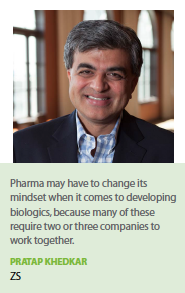 target toxicity, the new biologics present their own unique technical challenges, which make them riskier than conventional monoclonal antibodies. There is also the cost of developing and manufacturing biologics, which is higher because of the complexity of working with living cells.
target toxicity, the new biologics present their own unique technical challenges, which make them riskier than conventional monoclonal antibodies. There is also the cost of developing and manufacturing biologics, which is higher because of the complexity of working with living cells.
Dr. Levy cites Amgen’s Blincyto as an example. Blincyto was granted breakthrough therapy and priority review designations by the FDA in 2014, and is now approved in the United States for the treatment of relapsed or refractory B-cell precursor acute lymphoblastic leukemia (ALL) in adults and children, as well as for the treatment of adults and children with B-cell precursor ALL in first or second complete remission and minimal residual disease.
Blincyto is a bispecific CD19-directed CD3 T cell engager (BiTE) immunotherapy. The drug binds to CD19 expressed on the surface of cells of B-lineage origin and CD3 expressed on the surface of T cells.
“It is actually quite difficult to develop a bispecific product," Dr. Levy says. “It is more challenging to design a bispecific with acceptable biopharmaceutical properties, such as solubility and stability, which are crucial to the storage of the product and to its successful administration. Manufacturing a bispecific is considerably more difficult, and challenges around gaining an acceptable yield in the manufacturing process may make certain constructs prohibitive to commercialize."
For these reasons, it took almost three decades for the first meaningful bispecific product to reach the market. Amgen now has more than a dozen of these bispecific T cell engagers in the clinic or approaching the clinic.
To succeed in the biologics space, companies have to be willing to invest in expertise in protein design, discovery and process development, and manufacturing.
There are also regulatory and ethical issues related to biologics, says Sheila Frame, VP and head of biopharmaceuticals, North America, at Sandoz. “There continues to be an ongoing challenge for regulators to support the R&D process and balance those needs against patients’ access to new technologies," she says.
Industry experts say the ongoing shift to biologics will mean a different approach to clinical development, one that embraces collaboration of all types.
“In the oncology space where biologics are particularly prominent, collaborative studies are usually a key component of the development program," says David Balderson, Ph.D., global VP, safety operations, Sciformix, a Covance company.
“Approvals are not always based on traditional large Phase III studies, and there is more collaboration with academia and hospitals especially. Investigators and key opinion leaders are driving a lot of the strategy behind the development and what’s needed for patients."
2018 PharmaVOICE 100 Mir Imran, chairman and CEO of Rani Therapeutics, says there’s been a mushrooming of collaboration between large pharma companies and small biotech companies because the cost of developing biologics is so high.
“Small companies need partnerships and large companies need their pipelines to be 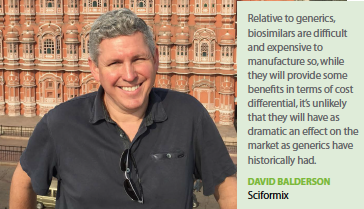 full," he says. “We are seeing more partnerships, acquisitions, and collaborations, and this is going to continue. Pharma companies are aggressively going after new therapies; they don’t want to be left out of the next up-and-coming area of drug development, such as cell therapies, various gene therapies, RNAi therapies, and CRISPR, which is one of the most exciting developments still in its nascent stage."
full," he says. “We are seeing more partnerships, acquisitions, and collaborations, and this is going to continue. Pharma companies are aggressively going after new therapies; they don’t want to be left out of the next up-and-coming area of drug development, such as cell therapies, various gene therapies, RNAi therapies, and CRISPR, which is one of the most exciting developments still in its nascent stage."
The industry in general is much more open to collaborations, whether it’s on the research or the commercial end, Ms. Frame says. “Collaborations help companies gain speed to market and accelerate the typical development process. The speed gained by collaborating is so significant that most organizations are becoming more open to partnering."
This is borne out by a review of the pipeline by Mr. Khedkar and his team, which assessed partnerships in development; they found 83 compounds in Phase III trials are being developed in combination. There are 25 companies creating therapies that are specifically to be used in combination with others.
Dr. Balderson says many companies developing biologics for indications with unmet medical needs may have the opportunity to file for approval earlier based on proven efficacy in smaller patient populations than has traditionally been the case. Yet, smaller patient populations mean datasets for both safety and efficacy are not as comprehensive when products go to market. “These inherent challenges require something of a mindset change for development of biologics in niche indications as they do not always follow traditional approaches and typically require more collaboration with partners during the development cycle," he says.
Gene and Cell Therapy Development
An ever-increasing need for new cures for orphan diseases and a rising incidence of cancers caused by mutations in genes are likely to increase the demand for gene therapies.
The number of gene therapy products in the pipeline — preclinical through Phase III studies and beyond — doubled between 2012 and 2015, according to Datamonitor Healthcare. In fact, FDA Commissioner Scott Gottlieb expects that by 2022, 40 FDA-approved gene therapy medicines will be on the market.
The gene therapy space is still maturing and is expected to reach $39.54 million by 2026, according to Grand View Research. Competition among manufacturers and the number of molecules in the pipeline are supporting the growth of the market. Analysts predict large pharma/biotech players to acquire small firms as many have been trying to develop in-house expertise and build their own pipelines.
UniQure’s Glybera (alipogene tiparvovec) was the first ever gene therapy to get the go-ahead by regulators when the European Medicines Agency approved it in 2012. But the product’s $1 million-plus price tag coupled with the small population of lipoprotein lipase deficiency patients it treated ultimately led to its demise. In April, UniQure decided not to seek reauthorization for the drug in Europe.
Still, Novartis researchers believe this is an area ripe for innovation and see this as a strategic growth area. Last year, the Novartis Institutes for Biomedical Research 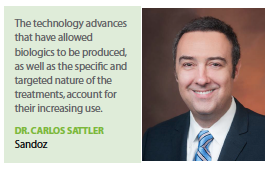 (NIBR) launched an initiative that focuses on cell and gene therapy that allows for collaboration across the organization and spans disease areas and technology platforms.
(NIBR) launched an initiative that focuses on cell and gene therapy that allows for collaboration across the organization and spans disease areas and technology platforms.
“We want to bring teams that are working on similar platforms together, for example vector delivery and that have broad use across multiple disease areas," says Sue Stevenson, Ph.D., executive director at NIBR. “This initiative allows for synergies to take place and helps to expedite the development in each of the identified areas. This approach has a real potential to be transformative."
Novartis’ launch of Kymriah set the stage for this new program. Kymriah, developed in collaboration with the University of Pennsylvania, became the first chimeric antigen receptor (CAR-T) therapy to receive regulatory approval in August 2017 for the treatment of patients up to 25 years of age with B-cell ALL. In May 2018, Kymriah received approval for its second indication — the treatment of adult patients with relapsed or refractory large B-cell lymphoma.
Dr. Stevenson says the company has recently started clinical trials of an adeno-associated virus (AAV) vector-based gene therapy in ophthalmology. Novartis in January 2018 initiated a licensing agreement with Spark Therapeutics covering development, registration, and commercialization rights to voretigene neparvovec in markets outside the United States. Spark received FDA approval for voretigene neparvovec, known as Luxturna, in December 2017 as a one-time gene therapy to restore functional vision in children and adult patients with mutations of the RPE65 gene.
Novartis also gained access to another gene therapy platform through the acquisition of AveXis, which was announced in April 2018. Novartis offered $8.7 billion for AveXis, which provides the company with AAV9 gene therapy manufacturing capabilities and valuable R&D capabilities. AveXis has several ongoing clinical studies for the treatment of SMA, an inherited neurodegenerative disease caused by a defect in a single gene, the survival motor neuron. AveXis’ lead gene therapy candidate is AVXS-101.
“AveXis is bringing to the table its expertise in large scale manufacturing of AAV, which Novartis didn’t have," Dr. Stevenson says. “We’re going to combine the best of both and develop a center of technical expertise on AAV with the combined group from Novartis Technical Development and AveXis."
Additionally, Novartis is collaborating with biotech companies, for example Intellia Therapeutics to develop the CRISPR-Cas9 gene editing technology. Dr. Stevenson says they are applying that technology in Novartis’ CAR-T program, as well as stem cell programs. Novartis also has a collaboration with Homology Medicines, which uses adeno-associated virus vectors derived from human hematopoietic stem cells to mediate gene editing.
The Biosimilar Market
The advent of biosimilars is intended to make biologics available to those who currently lack access. July 2018 marked the most recent biosimilar approval and that was for Pfizer’s Nivestym, which was also the second biosimilar approved to Amgen’s Neupogen. Neupogen treats neutropenia, a condition where the body makes too few neutrophils. Neutrophils are a type of white blood cell important in the body’s fight against infection. Neutrophils also help to reduce the risk of infection in those taking chemotherapy.
Nivestym follows Sandoz’s Zarxio, which was the first biosimilar approved in 2015 through the 2009 Biologics Price Competition and Innovation Act.
Sandoz has been a pioneer in the biosimilars space. In 2006, Sandoz received U.S. approval for its recombinant human growth hormone Omnitrope, the first follow-on version of a biotechnology drug to be approved. Omnitrope is similar to Pfizer’s Genotropin.
Filgrastim biosimilars, Cephalon’s Granix (approved as an original biologic in December 2012) and Sandoz’s Zarxio, together account for 49% of volume as of December 2017, according to IQVIA Institute for Human Data Science. An insulin glargine biosimilar, Basaglar, launched in December 2016, achieved a volume share of about 17% by the end of December 2017.
“Innovative products and generics will continue to exist but there will be a growing number of complex therapeutics that can’t be manufactured using small-molecule chemistry," Dr. Levy says. “This will represent a very distinct evolution in the market over the next decade."
The global biosimilars and follow-on biologics market was estimated to have been $7.70 billion in 2017 and it is expected to grow at a CAGR of 23.8%, according to Visiongain. The market is dominated by biosimilar monoclonal antibodies, a submarket that will be estimated to be a 24% share by 2022.
“As we look at the patent expiry of some of these biologic products, the potential is quite significant," Ms. Frame says. “This is where we expect to see a lot more activity."
RAND researchers estimate that biosimilars will cut spending on biologics by about 3% over the next decade.
Despite the optimism, there are still barriers to overcome to fully realize the benefit of biosimilars.
“The broad uptick of biosimilars in Europe has resulted in more appropriate use of biologics sooner, as well as cost savings to the system," Dr. Sattler says. “In the United States, in order to realize the benefits of biosimilars, there are a series of hurdles that must be overcome ranging from regulatory hurdles to the concept of interchangeability to patent and IP issues that still need to be resolved."
Some industry experts, however, say while biosimilars will provide benefits in terms of choice and offering a less expensive alternative for patients, they may not have the same degree of impact as generics have had on the traditional small-molecule market because of the associated research and manufacturing costs.
“The penetration of biosimilars has been slower than many people initially predicted," Dr. Balderson says.
Ms. Frame points out that payers are still very tentative in terms of how to handle biosimilars. “There’s a real desire by the three branches of the federal government to have much more transparency in terms of what the system looks like and how do we open up the opportunity for savings for patients," she says. “The evolution will continue. Based on our experience in Europe as well as our experience with the first approved biosimilar — Zarxio — under the regulatory pathway we’ll continue to break down those barriers and work directly with the payers." (PV)
~~~~~~~~~~~~~~~~~~~~~~~~~
The FDA New Biosimilar Plan
In July 2018, the FDA announced a Biosimilars Action Plan, part of the administration’s blueprint to lower drug prices and to modernize the agency’s policies that govern biosimilars. As part of this effort, the agency will establish a new Office of Therapeutic Biologics and Biosimilars to improve coordination and support of activities under the Biosimilar User Fee Act program.
The BAP is focused on four key areas:
Improving the efficiency of the biosimilar and interchangeable product development and approval process; Maximizing scientific and regulatory clarity for the biosimilar product development community; Developing effective communications to improve understanding of biosimilars among patients, clinicians, and payers; and Supporting market competition by reducing gaming of FDA requirements or other attempts to unfairly delay competition.
The effort will include developing and implementing new FDA review tools, such as standardized review templates, that are tailored biosimilar applications as a way to improve the efficiency of FDA review.
Additionally, the agency plans to publish final or revised guidance on biosimilar product labeling, as well as provide clarity on demonstrating interchangeability.





